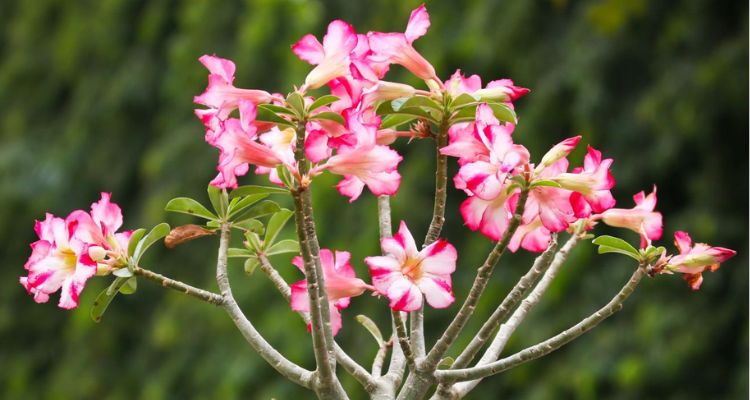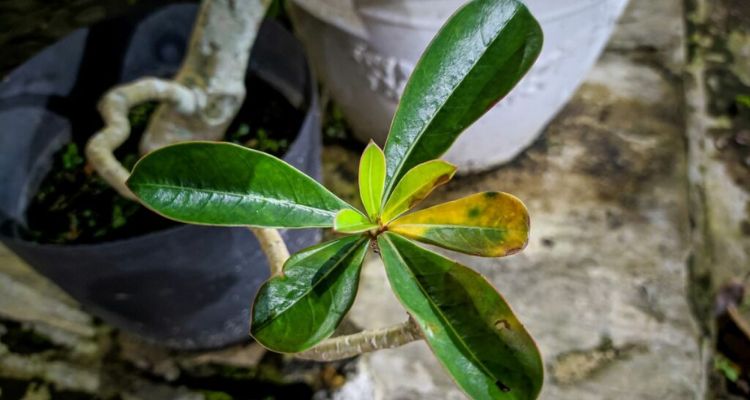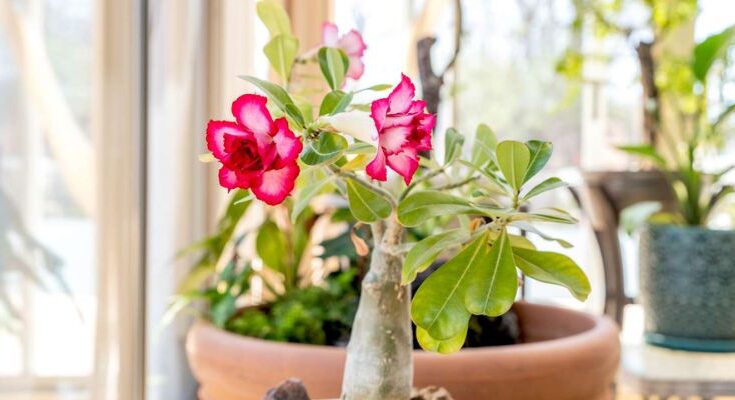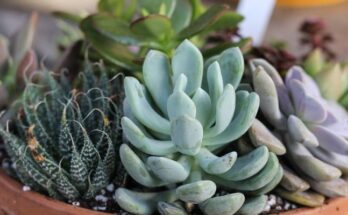|
Getting your Trinity Audio player ready...
|
The Desert Rose (Adenium obesum) epitomizes resilience, flourishing in arid African and Middle Eastern landscapes. Its distinctive, bonsai-like form boasts a thick, swollen trunk crowned by dark green leaves. This hardy succulent graces gardens with a burst of vibrant, trumpet-shaped flowers in hues ranging from pink to red. Adapting to harsh conditions, the Desert Rose requires minimal water, thriving in well-draining soil and sunlight. A symbol of endurance, this unique plant transforms adversity into an exquisite display of nature’s artistry, offering a touch of exotic elegance to gardens and indoor spaces alike.
Scientific Classification of Desert Rose (Adenium Obesum)
| Kingdom | Plantae |
|---|---|
| Division | Angiosperms |
| Class | Eudicots |
| Order | Gentianales |
| Family | Apocynaceae |
| Genus | Adenium |
| Species | obesum |
Desert Rose Plant Care
- Sunlight: Desert Roses thrive in full sunlight, requiring at least 6 hours of direct sunlight daily. Place them in a sunny spot, such as a south-facing window or outdoors in a well-lit area.
- Well-Draining Soil: Plant them in well-draining soil to prevent waterlogged roots. A cactus or succulent mix works well. Ensure the pot has drainage holes to avoid water stagnation.
- Watering: Practice moderation in watering. Let the soil dry between watering sessions to prevent overwatering, which can result in root rot. Use minimal water, especially during the dormant winter period.
- Temperature: These plants prefer warm temperatures between 65°F to 80°F (18°C to 27°C). Protect them from frost, as they are sensitive to cold temperatures.
- Fertilization: Feed with a balanced, water-soluble fertilizer during the growing season (spring and summer) every 2-4 weeks. Cut back or stop fertilizing during the fall and winter seasons.
- Pruning Trim to sculpt the plant and stimulate the growth of branches. Remove dead or unhealthy branches. Wear gloves as the sap can be mildly toxic and irritating to the skin.
- Pest Control: Monitor for typical pests such as aphids and spider mites. Address any infestations promptly using insecticidal soap or neem oil.
- Container Gardening: Suitable for container gardening, choose a pot that allows for root expansion. Repot every 2-3 years to refresh the soil and provide more space for growth.
- Dormancy Period: Understand and respect the natural dormancy period during winter, reducing watering and avoiding fertilization. The dormant phase is essential for the overall well-being of the plant.
Successfully caring for a Desert Rose involves a delicate balance of sunlight, soil, and water, ensuring a thriving and visually stunning addition to your plant collection.
Desert Rose Plant Seeds
- Origins and Variety: Desert Rose Plant (Adenium obesum) seeds come from a diverse species native to arid regions of Africa and the Middle East. These seeds boast a variety of cultivars, each offering distinct colors and forms, adding to the allure of this exotic plant.
- Appearance of Seeds: Desert Rose seeds are small and angular, often resembling tiny flat discs with a papery wing. They may vary in color, with shades ranging from light brown to dark brown.
- Germination Process: Germinating Desert Rose seeds is an engaging process. Soak the seeds in warm water for 24 hours to soften the hard outer coat. Plant them in a well-draining mix, maintaining a warm and humid environment for successful germination.
- Timing and Temperature: Sow seeds in spring or early summer when temperatures are consistently warm. The ideal germination temperature ranges from 75°F to 85°F (24°C to 29°C).
- Seedling Care: Once seedlings emerge, provide ample sunlight for healthy growth. Introduce them to direct sunlight gradually to prevent sunburn.
- Transplanting: After the seedlings develop several leaves and a robust root system, transplant them into individual pots with well-draining soil. As they mature, transplant to larger containers.
- Patience in Growth: Desert Rose plants grow slowly from seeds, requiring patience. The reward is a unique and resilient plant with a distinctive caudex and stunning flowering display.
- Caring for Young Plants: Young Desert Rose plants need careful attention to watering, avoiding overhydration. Establish a routine and adapt it as the plant matures.
- Adaptation to Local Conditions: Once established, Desert Rose plants acclimate to local conditions. They thrive in sunny, dry environments, reflecting their natural habitat.
Growing Desert Rose from seeds offers a captivating journey, from the intriguing appearance of the seeds to the eventual blooming of these resilient and enchanting plants.
Desert Rose Plant Benefits

- Aesthetic Beauty: The Desert Rose plant, with its striking appearance and vibrant blooms, enhances the visual appeal of gardens, landscapes, and indoor spaces, adding a touch of exotic beauty.
- Adaptability: Known for its resilience, the Desert Rose thrives in arid conditions, making it a perfect choice for water-wise gardening. Its ability to endure dry spells and high temperatures makes it a low-maintenance plant.
- Air Purification: Like many plants, the Desert Rose contributes to air purification by absorbing carbon dioxide and releasing oxygen. This can create a healthier and more refreshing indoor environment.
- Stress Reduction: Gardening, including tending to Desert Rose plants, has been linked to stress reduction and improved mental well-being. The process of caring for these plants can be a therapeutic and rewarding experience.
- Symbol of Strength: The Desert Rose’s ability to flourish in challenging environments symbolizes strength and endurance. It serves as a reminder of nature’s resilience, making it a meaningful addition to gardens and landscapes.
- Bonsai Artistry: With its naturally bonsai-like form, the Desert Rose lends itself well to bonsai cultivation. This allows enthusiasts to create miniature, artistic representations of these captivating plants.
- Cultural Significance: In various cultures, the Desert Rose holds symbolic value. It is often associated with endurance, beauty, and the ability to thrive in adversity, making it a meaningful gift or addition to gardens with cultural significance.
- Medicinal Uses: In traditional medicine, some cultures use parts of the Desert Rose for medicinal purposes, although it’s essential to approach such uses with caution and consult with experts.
- Educational Value: Growing and caring for Desert Rose plants provides an educational experience, offering insights into the adaptations of plants to arid climates and encouraging an appreciation for biodiversity.
Whether for its visual allure, adaptability, or symbolic meaning, the Desert Rose stands as a multifaceted plant with numerous benefits for both the environment and those who cultivate and admire it.
Desert Rose Plant Vastu
- Symbol of Prosperity: In Vastu Shastra, the Desert Rose plant is often considered a symbol of prosperity and abundance. Its vibrant and blooming appearance is believed to attract positive energy associated with wealth and success.
- Positive Energy Flow: Placing a Desert Rose plant in specific areas of the home, such as the southeast or northwest corners, is thought to enhance positive energy flow. This aligns with Vastu principles aimed at creating a harmonious living environment.
- Removal of Negative Energy: The Desert Rose is believed to have the ability to absorb negative energy from its surroundings. This makes it a popular choice for Vastu practitioners seeking to cleanse and purify the energy within a space.
- Balancing Elements: According to Vastu, the Desert Rose, with its earthy and grounding qualities, helps balance the elements within a home. Its presence is thought to harmonize the space, promoting a sense of stability and well-being.
- Indoor and Outdoor Placement: While the Desert Rose is suitable for indoor spaces, placing it in the garden or outdoor areas aligns with Vastu recommendations for inviting positive energy into the entire property.
- Cautious Placement: Vastu guidelines suggest avoiding placing the Desert Rose in certain areas, such as the bedroom. It’s advised to consult with a Vastu expert to determine the most auspicious placement based on the specific needs and energy dynamics of the space.
- Maintenance and Care: To maximize the Vastu benefits, it’s important to keep the Desert Rose healthy and well-maintained. Regular pruning and proper care contribute to its positive influence on the energy of the surroundings.
- Rituals and Offerings: Some Vastu practitioners incorporate rituals and offerings when placing the Desert Rose, such as lighting candles or incense. These practices are believed to amplify the positive vibrations and energies associated with the plant.
In Vastu, the Desert Rose plant is regarded not only as a botanical delight but also as a powerful tool for channeling positive energy and fostering prosperity within the home or workplace.
Desert Rose Plant Leaves Curling

- Environmental Stress: One common reason for Desert Rose plant leaves curling is environmental stress. Sudden changes in temperature, exposure to drafts, or extreme heat can lead to leaf curling as the plant reacts to protect itself.
- Underwatering: Insufficient water supply is a frequent cause of leaf curling. Desert Rose plants need regular watering, especially during the growing season. If the soil becomes excessively dry, the plant conserves moisture by curling its leaves.
- Overwatering: Paradoxically, overwatering can also result in leaf curling. Desert Rose plants prefer well-draining soil, and excessive moisture can lead to root rot, causing stress that manifests in curled leaves.
- Pests and Diseases: Infestations by pests like spider mites or diseases such as powdery mildew can cause stress to the plant, leading to leaf curling as a response to the damage.
- Nutrient Deficiency: A lack of essential nutrients, particularly magnesium or potassium, can contribute to leaf curling. Providing a balanced fertilizer can address this issue and promote healthy growth.
- Natural Dormancy: Desert Rose plants may naturally enter a dormant period during winter, and some leaf curling can be a normal part of this process. Adjusting care during this season is essential to support the plant’s natural rhythm.
- Cultural Practices: Improper pruning or disruptions to the plant’s natural growth pattern can induce stress and result in leaf curling. Pruning should be done judiciously to maintain the plant’s health.
- Adjustment Period: If the Desert Rose plant is recently transplanted or moved to a new location, it may undergo an adjustment period, during which leaf curling can occur. Providing stable conditions and patience is key during this phase.
Addressing the specific cause of leaf curling, whether related to environmental factors, watering, pests, or nutrient deficiencies, is crucial for restoring the Desert Rose plant’s health and ensuring its leaves regain their natural, vibrant appearance.
Desert Rose Plant Pruning
- Timing: Pruning Desert Rose plants is most effective during the dormant season or early spring before new growth begins. This minimizes stress on the plant and allows for a rejuvenated appearance during the growing season.
- Tools: Utilize sharp and sanitized pruning shears or scissors for accurate cuts. Ensure tools are sterilized before use to curb the spread of diseases.
- Remove Dead or Yellowing Leaves: Start by trimming away any dead, yellow, or diseased leaves. This not only enhances the plant’s aesthetic appeal but also promotes overall health by preventing the spread of diseases.
- Shape and Structure: Prune to maintain a balanced and desirable shape. Desert Rose plants naturally adopt a bonsai-like structure, and strategic pruning can enhance this form. Focus on maintaining an open and well-ventilated structure.
- Encourage Branching: To encourage lateral growth and branching, selectively prune the tips of branches. This promotes a fuller appearance and can lead to more abundant flowering.
- Cautious with Caudex: The caudex, the swollen trunk characteristic of Desert Rose plants, should be pruned sparingly. Removing excess growth around the caudex can accentuate its natural beauty, but avoid excessive cutting to preserve the plant’s vitality.
- Control Size: If the Desert Rose has outgrown its space, prune for size control. Be mindful of the plant’s natural growth pattern and avoid drastic cuts, as Desert Rose plants are sensitive to major pruning.
- Healing and Sealing: After pruning, allow cut surfaces to dry and heal naturally. Applying a thin layer of pruning sealer or cinnamon can help protect against infection.
- Clean Surroundings: Remove any debris or fallen leaves around the base of the plant after pruning to prevent the accumulation of pests or diseases.
Pruning a Desert Rose plant is a careful and strategic process that, when done thoughtfully, contributes to its overall health, aesthetic appeal, and longevity. Regular maintenance through pruning ensures a flourishing and visually pleasing specimen in your garden or home.
Wrapping Up
The Desert Rose, with its resilient nature and vibrant allure, emerges as a symbol of natural elegance. From meticulous care guidelines and the captivating journey of growing from seeds to exploring its significance in Vastu, the Desert Rose offers a diverse and enriching experience. As we embrace its unique beauty and symbolic value, the plant becomes a living expression of endurance and harmony. Whether adorning gardens or indoor spaces, the Desert Rose transcends mere horticulture, inviting us to appreciate the delicate balance of nature and the artistry embedded in its every leaf and bloom.
Don’t Miss: Teak Tree | Uses, Leaves, Wood, Benefits, Life Cycle & Growing



